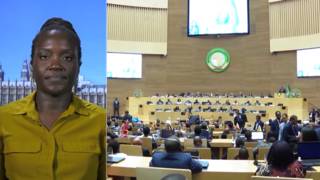
The world saw the highest number of state-based conflicts last year since the end of World War II, as fighting raged in Gaza, Ukraine, Sudan, the Democratic Republic of Congo, Ethiopia and other areas. That’s the finding of a new report from the Peace Research Institute Oslo. Siri Rustad, research director at the Norwegian think tank, tells Democracy Now! that it’s a worrying trend. “The three past years are the three most violent years since the Cold War,” she says.
Transcript
AMY GOODMAN: This is Democracy Now!, democracynow.org, The War and Peace Report. I’m Amy Goodman, with Nermeen Shaikh.
NERMEEN SHAIKH: The United Nations Refugee Agency announced earlier today that a record 120 million people are now displaced around the world. Filippo Grandi, the U.N. high commissioner for refugees, spoke in Geneva.
FILIPPO GRANDI: The last figure that we had been sharing with you, if you recall, was 114 million. So, we estimate that the most updated figure is now 120 million, so it has gone up by another 6 million. These are refugees, asylum seekers, internally displaced people, people being forced by conflict, by persecution, by different and increasingly complex forms of violence. … The way conflicts are conducted by the parties, almost everywhere, by almost all parties, in complete disregard of the laws of war, of international humanitarian law, and often with the specific purpose of terrorizing people, of making people instill fear in people, this, of course, is a powerful contributor to more displacement than even in the past.
AMY GOODMAN: This comes as a new report from the Peace Research Institute Oslo has found there were more armed conflicts last year than in any year since World War II, as fighting rages in Gaza, Ukraine, Sudan, the Democratic Republic of Congo, Ethiopia and other areas.
We’re joined right now by Siri Rustad, research director at the Peace Research Institute Oslo.
Siri, I hope by saying your name, I’m not activating everyone’s Siri. But if you can start off by just summarizing the main findings of your report?
SIRI RUSTAD: The report is based on data from the Uppsala Conflict Data Program at the University of Uppsala, and which collects conflict data every year. And this year, we see that the number of conflict has reached a record high with 59 conflicts all over the world. The way that these conflicts are defined is that they are what we call state-based conflicts, which include where the state is part of the conflict, meaning either conflicts between states, like Russia-Ukraine, or civil wars. What we also see this year is there’s a decrease in people being killed in conflict. But this says more about the number of people being killed last year rather than this year, because of the conflict in Ethiopia last year, as well as Ukraine. So, we actually see that in the three past years are three most violent years since the Cold War.
NERMEEN SHAIKH: And so, could you talk about, Siri, some of the least reported but the deadliest? You mentioned Ethiopia, but also the DRC and Sudan, which are not really reported on nearly as much as either Ukraine or Gaza.
SIRI RUSTAD: No, absolutely. And this is partly why we published this report, is to put focus on these conflicts, as well. So, Ethiopia was a conflict that went on mainly in 2021 and '22 in the Tigray region. And I think it took a lot of people by surprise last year when we realized the number of people being killed, partly because of a lack of attention, because of the conflict in Ukraine taking most of the attention, but also the lack of access to the Tigray region by journalists, but also an internet blackout, so there's very little sources to understand what’s actually going on. But what we see is that over 2021 and ’22, the number of people killed in Ethiopia surpasses the number of people killed in Afghanistan since the end of the Cold War and is at the height of the number of people being killed in Syria. So, it is one of the most bloodiest and deadliest conflicts we have seen in the past 30 years, and attention is extremely low.
NERMEEN SHAIKH: And so, could you explain, Siri? In places like that, the organization that you rely on in this report is the Uppsala Conflict Data Program, UCDP, which collects data on conflicts worldwide. How do they get access to this information in places like Ethiopia or the DRC, where access to areas is difficult and also where there are multiple conflicting parties, especially in the DRC? How do they get —
SIRI RUSTAD: Yes.
NERMEEN SHAIKH: — for example, the number of casualties, fatalities, etc.?
SIRI RUSTAD: Yeah. So, the way they code this data is that they code conflict events. So, when something happens, they code it, and they try to establish who are the conflicting parties, where was it, and how many people were killed. Of course, in some areas, like Ukraine, you have a lot of sources reporting on this, news sources, etc., while in, for example, Ethiopia, there is hardly anything. So, last year, in 2022, they were able to find one report by Amnesty, who reported 100,000 killed. But that was the only report they could find. This year, they have been able to supplement the death tolls for 2022 with other reports from the military. But to get access, they use news reports, they use NGO reports, they use social media occasionally. But they also try to make sure that these events are reported by several sources, so that they can get the best estimate possible. Of course, this probably means that the numbers that they use are conservative, but they will still give us an idea of the trends that we see.
AMY GOODMAN: Siri Rustad, we want to thank you so much for being with us, research director at the Peace Research Institute Oslo, author of the new report, “Conflict Trends: A Global Overview, 1946-2023.” We’ll link to it at democracynow.org.
Coming up, we speak to the deputy permanent observer of the State of Palestine to the United Nations. Stay with us.
[break]
AMY GOODMAN: “Danger” by The Selecter. The group’s vocalist, “Gaps” Hendrickson, died this week at the age of 73.











Media Options